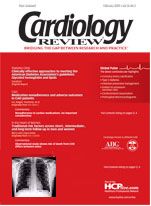Publication
Article
Cardiology Review® Online
Identifying silent coronary artery disease in diabetic patients
Type 2 diabetes now poses a significant health risk for this country. The increasing prevalence of this disease, along with its associated cardiovascular morbidity and mortality, presents one of the greatest health care challenges of the 21st century.
The study by Zellweger and colleagues (page 22) examined 1,737 consecutive clinic patients with type 2 diabetes, following 1,430 of these patients for 2 years. All patients
in this study had myocardial perfusion single photon emission computed tomography (SPECT) imaging in the initial stages of their evaluation for coronary artery disease (CAD). The cohort of 1,430 patients was followed up for nonfatal myocardial infarction and cardiac death as study end points. More than half of the patients in this study were asymptomatic and remained without symptoms until the study was completed or the end points reached. Thirty-five percent of patients complained of anginal symptoms, and 5% had shortness of breath on presentation.
The results of this study were very revealing. During the follow-up period, there were 98 cardiac events, for an annual cardiac event rate of 3.1%. Cardiac event rates were stratified by presenting complaints as follows: 2.2% for asymptomatic patients, 3.2% for patients presenting with angina, and 7.7% in a small cohort of patients presenting with shortness of breath. Patients with a normal myocardial perfusion SPECT had a significantly lower annual event rate compared with patients with abnormal perfusion studies (1.9% versus 5.4%; P < .001). This result was consistent for all patients, regardless of their presenting symptoms. Using a Cox proportional hazards model, age, hypertension, shortness of breath as a presenting symptom, and the degree of abnormality on myocardial perfusion SPECT (ie, extent of scarred or ischemic myocardium) were predictors of cardiac events.
The clinical implications of this study are profound. In a low-risk population of type 2 diabetic patients (most being asymptomatic), 39% had objective evidence of CAD. The majority of patients thus had evidence of silent disease. This result is consistent with the Detection of Ischemia in Asymptomatic Diabetics (DIAD) trial, which showed that 27% of patients had perfusion imaging evidence of CAD. These data should be interpreted in conjunction with the predictors of cardiovascular events in the present study of mostly asymptomatic diabetic patients. The most important of these factors are age and hypertension.
How can we translate these results into clinical practice? First, in a select population of type 2 diabetic patients with advanced age and hypertension, one could make an argument for routine noninvasive screening studies, such as myocardial perfusion SPECT, to identify even asymptomatic patients at risk for cardiac morbidity and mortality. Recent data have also identified the ankle— brachial index as a similar predictor in the general cardiac population.
Selecting patients with this clinical profile (elderly, diabetic, and hypertensive) for these noninvasive screening studies may prove invaluable in the subsequent clinical management. n
